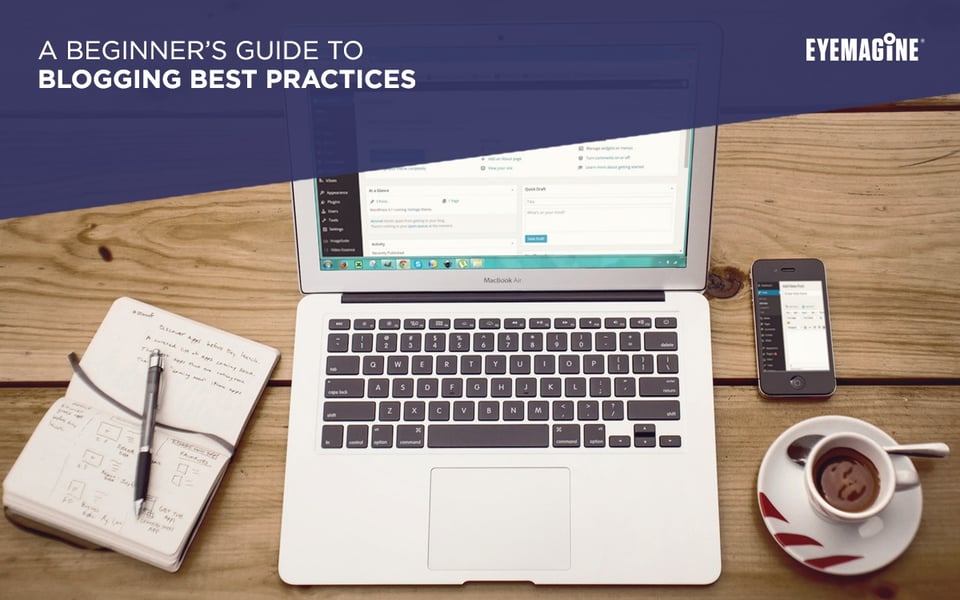
Consistent blogging is key to any effective marketing plan.
According to HubSpot, companies that blog 16 times per month get 4.5 times more leads than companies that only publish 4 posts per month.
But in order for your blogging to produce these kinds of results, it has to be strategic and follow best practices.
If you’re new to blogging and want to learn how it can be used as a tool to get more leads and traffic to your website, you’ve come to the right place.
Keep reading as we share some of the best practices for blogging, from the planning to publishing stages, that will lead to better results for your business.
Blogging Best Practices
Planning
- Creating effective blog posts starts with knowing as much as you can about your target audience. The best blogs are educational and informative, speaking directly to a buyer persona’s pain points. How can you get to the bottom of your buyers’ needs and desires? Check out this helpful blog post to learn more about buyer insight analysis.
- In addition to basing your blogging strategy off of buyer persona research, you should also be conducting keyword research with a tool like Moz to find out what your audience is searching for online. These search terms will provide a wealth of ideas for blog posts.
- Use tools like SpyFu to see which keywords your competitors are targeting and ranking for. This will show you what’s working for them, and give you ideas about how you can create bigger and better content.
- Organize all of your ideas for blog posts into an editorial calendar, also known as a content calendar. An editorial calendar will keep your team of content contributors aligned and on track to meeting your blogging goals.
SEE ALSO- 8 Blogs That Get Conversions & What We Learned From Them
Creating
- Try to keep all of your blog post titles at 60 characters or less. Why? If it’s any more than that, it will get cut off on Google search results pages. Searchers are less likely to click on an article if they can’t tell what it’s about from the visible title.
- If the goal of your blogging efforts is to increase organic traffic to your website, then focus on creating long form content. Google favors in-depth pieces that are 2,000 words or more in length. In lengthy blog posts like these, remember to break up your text with bolded phrases, different font sizes, and short paragraphs like CopyHackers does here.
- Make sure you’re including keywords with high search volume and low ranking difficulty throughout your blog post, but avoid keyword stuffing. Keywords should appear naturally and seamlessly throughout an article. If it makes sense, put them in your title, headings, and alt text.
- Within every blog post, you should include relevant, internal links that connect readers with other helpful content on your website. This could be in the form of a “See Also” link, or it could mean simply linking words and phrases, like we do here.
- Research shows that outbound links to relevant, authoritative websites might also be important to Google. Whether or not that’s true, if you quote or reference a trustworthy site with high domain authority, it’s good practice to link back to that website. Just make sure the link will open in a new window for the reader.
Publishing
- When publishing a blog, there should always be a relevant call-to-action within the post that moves visitors further down the buyer’s journey. A couple ideas for successful CTAs: ask visitors to subscribe to your newsletter, or promote an offer encouraging them to buy your product.
- Use marketing software that allows you to preview your blog posts on a variety of devices before publishing, like HubSpot does. This is an essential step to confirm that all content, including images, will appear correctly on mobile phones and tablets.
- Once your blog post is published, your job isn’t over yet. The best bloggers monitor the performance of their previous posts and look for new ways to optimize them. You might have an old post that is getting a lot of traffic but not a lot of CTA clicks because of bad design. Don’t miss out on opportunities to improve old blog posts.
- What’s the point of creating great content if nobody even knows it exists? A few tips and tricks - set up auto sharing to promote your new blog posts instantly across your social media channels, invest in sponsored posts or paid ads, and send out email updates to your customers to share your new content.
SEE ALSO- Copywriting: The Simple Secret to Marketing Success
Each of these best practices will help ensure your blogging strategy achieves maximum results for your business. By following these guidelines you will begin to see more traffic, more leads, and a better ROI.
This is by no means a comprehensive list, but it is an excellent starting point. You should also be spending some time moderating comments on your blog posts, keeping up to date with industry news, and guest blogging.
Want to find out more about how blogging can enhance your current marketing efforts? Contact EYEMAGINE today to consult with a marketing and content strategist.

